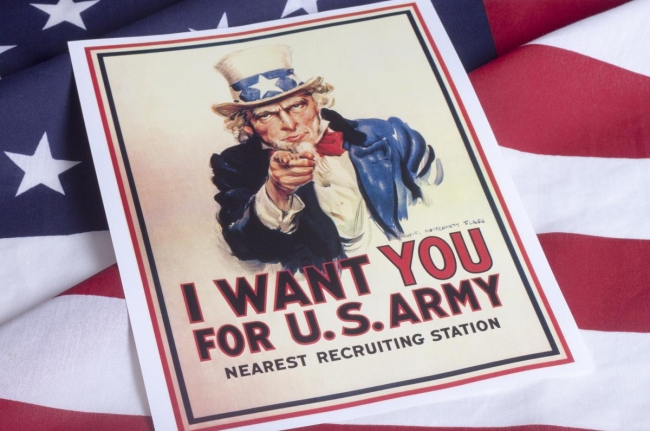You have /5 articles left.
Sign up for a free account or log in.

danielfela/iStock/Getty Images Plus
This year marks the 50th anniversary of the end of the military draft and the birth of America’s all-volunteer force, and the golden anniversary comes at a time when the future of the volunteer military has never been more uncertain. In fiscal year 2022, the U.S. Army missed its recruitment target by a record 25 percent, or 15,000 soldiers. Even applications to the elite service academies—long insulated from social and economic pressures—declined in 2022, with those declines ranging from 10 percent to almost 30 percent.
Many believe that 20-plus years of war, a global pandemic, political division and low unemployment have set the conditions for the worst fears of the architects of the all-volunteer force to be realized. First among those fears is that social and economic factors would combine to impose an opportunity cost on young Americans considering military service, otherwise overwhelming motivations grounded in patriotism and citizenship. Now, more than ever, that opportunity cost is palpable.
Today, entry-level salaries in the civilian sector are at historically high levels, and unfilled U.S. jobs exceed 10 million. Meanwhile, Congress has set the annual salary for a new military enlistee at less than $26,000. In August, the Army had no choice but to issue guidance instructing soldiers and families to consider food stamps as a strategy to combat inflation. All this comes when the pool of eligible volunteers is small and shrinking. According to the Department of Defense, upwards of 70 percent of American youth are ineligible to serve even if inclined to do so, most commonly for reasons of obesity, drug or alcohol abuse, or other disqualifying medical conditions.
In many ways, the same challenges facing the military are also disrupting higher education. Undergraduate enrollment has consistently declined in recent years. It’s easy to cite the pandemic as the culprit, but higher education’s enrollment crisis has been festering for more than a decade. As the cost of education increases, and as certifications and credentials emerge as a degree alternative, the opportunity cost associated with the traditional college experience has increased for many students and families.
This situation, combined with burdensome debt, explains why more than 500 U.S. colleges and universities closed their doors over a recent three-year period. And for America’s colleges and universities, the worst is yet to come. Right now, college administrators are scrambling to prepare for the impending demographic cliff—a dramatic decline in the number of high school graduates set to hit in 2025, stemming from historically low birth rates in the decade following the 2008 recession.
Since the advent of the all-volunteer force, the military and higher education have competed for the attention of American youth. Now, however, two of our nation’s most prominent institutions must simultaneously confront demographic and opportunity cost problems that will pit higher education and the Defense Department in direct competition like never before.
However, this shared dilemma may present a shared opportunity for both institutions, and for the nation.
One of the top reasons consistently cited by those who volunteer for military service is the opportunity to leverage the GI Bill and other military tuition assistance benefits. At the same time, even a sympathetic critique of the degree to which America’s best colleges and universities have meaningfully engaged the post–Sept. 11 generation of military-connected students would suggest indifference at best. At worst, that critique would describe an implicit rejection of any responsibility to contribute to enacting the promise of the GI Bill. For more than 10 years Wick Sloane has conducted an annual survey for Inside Higher Ed focused on capturing the extent to which the nation’s selective colleges and universities engage and enroll veterans. He declared his 2021 survey “a disaster,” noting that “the undergraduate veteran enrollment remains stalled at near zero.” His 2022 survey found some progress, even as many selective institutions remained inattentive to the issue.
“All I want,” Sloane wrote, “is for the self-proclaimed top colleges and universities in the world to educate graduates who can solve problems without sending other people’s children to war.”
Sloane has stated this goal before, but never at a time when the strategic challenges and interests of the Defense Department and higher education have potentially been so aligned.
For example, if service as a pathway to a college degree is indeed why many volunteer, could the Pentagon mitigate the opportunity costs our service members incur via new and innovative partnerships with institutions of higher education? Similarly, for universities to lessen the pain of the looming demographic cliff, could they do so by partnering with the Defense Department to enhance college access and affordability for military-connected students?
These and similar questions will be explored in April, when Syracuse University and the University of Tennessee will convene leaders from across higher education and government. The objective of this summit is to consider opportunities for collaboration to address the Defense Department and higher education’s shared challenges—and, by extension, mitigate the opportunity costs incurred by those who volunteer to shoulder the burden of the nation’s defense.
Given the real and present threat to the volunteer force, this summit is not without risk. That’s because the willingness—or not—of leaders to engage on these issues will preview for the next generation of potential volunteers if military service continues to be socially regarded and institutionally supported as our nation’s ultimate expression of citizenship.




